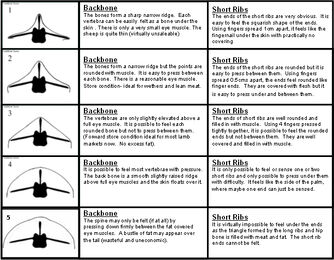Examining a sheep is the process of restraining an animal while inspecting key areas such as teeth and feet and body condition in order to gain an idea of the animal's overall health.
It is important for monitoring the health of an individual and of the whole flock. Sick animals quickly lose condition and a physical examination is a good way to identify problems before they get out of hand.
The body condition scoring and checking the condition of feet and teeth are key components of the physical examination process.
Physical Examination[]

Examining an Ewe
An easy way to remember the steps of examining a sheep is the "3 T's". In ewes (female sheep) this stands for: Teeth, Toes, Teats and in rams (male sheep) for Teeth, Toes, Testicles/Penis.
These will be things you are looking out for during the physical examination:
- Count teeth: Sheep grow two new incisors each year. Therefore, a yearling will have two permanent incisors, a two year old sheep will have four incisors and four year old sheep will have a full mouth of eight permanent incisors. Apart from assessing the age, it is further important to check for broken teeth. Sheep with these are referred to as "broken mouth" and it prevents them from grazing efficiently leading to a loss of condition.
- Toes: Sheep can be very prone to foot rot, particularly in damp areas and so must be regularly checked for foot infections and abscesses. Symptoms include [] To prevent this it is important to clean and cut the hooves .

Sheep examination checklist.
- Testicles (Rams): Check that scrotum contains two testicles, that they are approximately even in size and there are no bumps on the testicles or on the sperm duct. (Why is this important?)
- Teats (Ewes): Teats can sometimes be accidentally cut during shearing. This can lead to infections and problems may arise when the ewe is suckling twins as she only has one teat and hence can only feed one lamb. It is therefore important to ensure that all teats are present and infection-free.
Condition scoring

Source: Lifetime Wool- Condition Scoring of Sheep http://www.lifetimewool.com.au/conditionscore.aspx
Condition scoring is an important way of monitoring the health of a sheep and a useful way of estimating its approximate weight. Determining the body condition score (BCS) is a skill best learnt through practical application and it can take a lot of practice before you get confident in estimating a sheep’s condition. The optimum condition score is between 2.5-3.5 for healthy animals although ewes main lose condition when lactating.
1. Place hand on back with thumb on the spine and fingers interlocking short ribs and move hand back and forth in order to gage the depth of the fat over the spine and the hollows between the ribs.
Do you feel ready to take the quiz on examining sheep? Click Here!